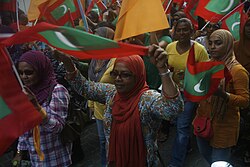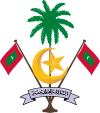Women in the Maldives
This article needs additional citations for verification. (August 2021) |
 Maldivian women attending the 2012 International Women's Day March in Malé | |
| General Statistics | |
|---|---|
| Maternal mortality (per 100,000) | 60 (2010) |
| Women in parliament | 6.5% (2012) |
| Women over 25 with secondary education | 20.7% (2010) |
| Women in labour force | 55.7% (2011) |
| Gender Inequality Index[1] | |
| Value | 0.369 (2019) |
| Rank | 82th out of 162 |
| Global Gender Gap Index[2] | |
| Value | 0.662 (2018) |
| Rank | 113th |
The status of Women in the Maldives was traditionally fairly high, as attested to in part by the existence of four Sultanas.[3] Although the majority of Maldivian today women wear the veil,[4] this is a phenomenon experienced in the past two decades or so, possibly as a response to increased religious conservatism.[citation needed] Women are not strictly secluded, but special sections are reserved for women in public places in some events.[3] However, those women who refuse to wear a veil or decide to remove it face social stigma[4] from both their families and members of the public.[5] Women do not adopt their husbands' names after marriage but maintain their maiden names.[3] Inheritance of property is through both males and females.[3] With one of the highest divorce rates in the world, women in general have enjoyed marriage and divorce rights throughout history. Both divorced men and women face no stigma, and historically women also have the right to initiate divorce.[citation needed]
Catcalling and sexual harassment are major problems in Maldives for Maldivian and foreign women alike. Women find that it is a daily part of their lives to be harassed in the streets. A total of 96% of women in the Maldives reported having been harassed in the streets at some point in their lives, with 60% facing harassment before turning 16 and 40% reporting being sexually harassed before they turned 10.[6] Men of all ages find catcalling perfectly acceptable in especially Male' city. Little to no action is taken against people who harass women and the number of sexual assaults and rapes are increasing.[7]
In today's society some women hold positions in government and business but they are heavily under-represented. As of 2016 women only accounted for three out of 14 government ministers, five out of 85 lawmakers and six out of more than 180 judges.[8] However the vast majority of Civil Servants are female employees. The male female ratio of enrolment and completion of education to secondary school standards remains equivalent, with female students academically exceeding the results of male students in recent years.[citation needed] But on average they earn less than half the salaries of men in the workplace,[9] possibly as a consequence of a higher male education levels a few decades ago. However, with the increased number of females who pursue higher education, which is set to overtake males this is likely to change in the near future. This change is also seen positively in the birth rate, which currently sees the Maldives on a negative birth rate, due to prolonged educational periods and change in social norms.[citation needed]
Polygamy in the Maldives is legal, but very rare. Prostitution in the Maldives is illegal. Homosexuality is illegal.[citation needed]
In 2013, a 15-year-old rape victim received a sentence of 100 lashes for fornication. The sentence was later overturned by the Maldivian High Court, following an international petition campaign led by Avaaz.[10] A disproportionate number of women face public flogging for extra-marital sex compared to men: the majority of men accused of extra-marital sex are acquitted.[11] (Maldivian law only enforces punishment to these actions only through admission. Even though the Maldives is a 100 percent Muslim country for nearly a thousand years, there is no record of stoning, or execution for murder unlike most other Islamic or Non-Islamic nations across the world.[citation needed])
References[]
- ^ "Gender Inequality Index" (PDF). HUMAN DEVELOPMENT REPORTS. Retrieved 27 October 2021.
- ^ "The Global Gender Gap Report 2018" (PDF). World Economic Forum. pp. 10–11.
- ^ a b c d Ryavec, Karl E. (1995). "Maldives: Social Structure". In Metz, Helen Chapin (ed.). Indian Ocean: five island countries (3rd ed.). Washington, D.C.: Federal Research Division, Library of Congress. pp. 266–267. ISBN 0-8444-0857-3. OCLC 32508646.
 This article incorporates text from this source, which is in the public domain.
This article incorporates text from this source, which is in the public domain.{{cite encyclopedia}}: CS1 maint: postscript (link) - ^ a b "MALDIVES 2016 INTERNATIONAL RELIGIOUS FREEDOM REPORT" (PDF). US Government. 2016. Archived from the original (PDF) on 2017-08-15.
- ^ "Hijab and the Maldives: stigma, shaming and the struggle to take it off | Maldives Independent". maldivesindependent.com. Retrieved 2018-05-15.
- ^ "UNFPA Maldives | Maldivian Women say #MeToo". maldives.unfpa.org. Retrieved 2018-05-15.
- ^ "Women's group speaks out over sexual abuse | Maldives Independent". maldivesindependent.com. Retrieved 2018-05-15.
- ^ "Female candidates win majorities on four island councils | Maldives Independent". maldivesindependent.com. Retrieved 2018-05-15.
- ^ "Maldives: Women's Representation in Political Processes —". aceproject.org. Retrieved 2018-05-15.
- ^ "Maldives rape victim spared the lash after global anger". The Independent. 2013-08-24.
- ^ "150 women face adultery flogging on Maldives". The Independent. 2009-07-22. Retrieved 2018-05-15.
- Women in the Maldives
- Women by country
